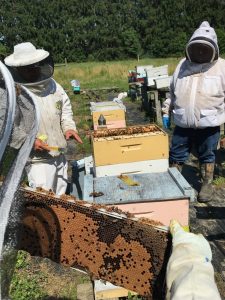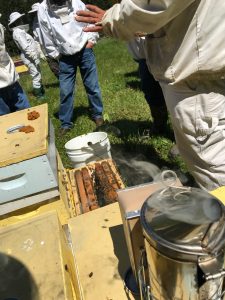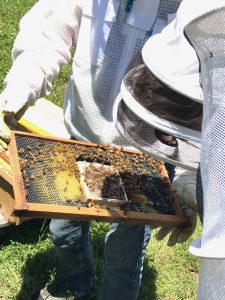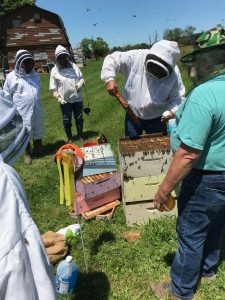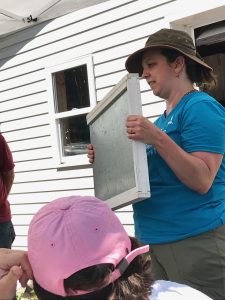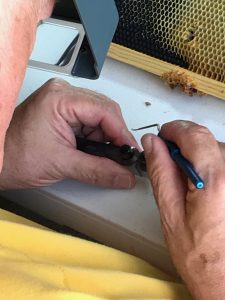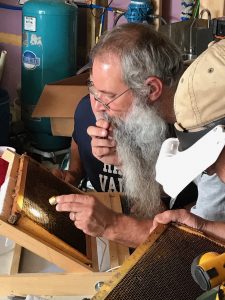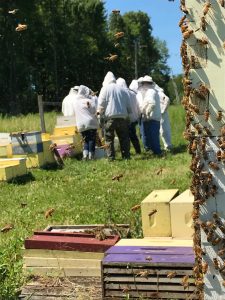Final report for FNE18-886
Project Information
Our objective was to change the behavior of 100 hobbyist beekeepers by having them compare colonies with queens from a MBB/mite-resistant stock versus a Control. By giving these beekeepers hands-on experience of measuring mite levels, honey production, chewing behavior and winter survival, we anticipated they would change their attitudes about the need for monitoring and mite management. The study took place starting in June 2018 and went though March of 2019 and took place in Pennsylvania, West Virginia, and Ohio, and cooperation with Penn State, Purdue and Heartland Honey Bee Breeders Coop (HHBBC)
Looking back over the project we can say it was a success. Primarily, we can say this because it raised awareness of what we are doing by trying to get beekeepers to adopt improved genetics, along with the other IPM practices that are part of successful beekeeping in the age of Varroa mites. We feel we have indeed increased the knowledge, attitude, and awareness about monitoring mite infestations, and the needed treatment, of the beekeepers in the study and the participating clubs. But implementation of these skill by the beekeepers in day to day practice is still poor. We can say this because 76% of the beekeepers did not perform any measurement at all, and of the 24% that did turn in data, about half was incomplete. Because of these results, it made data analysis difficult.
Moving forward, the PA Queen Improvement Project, HHBBC, and other states queen organizations still plan to hold field days and distribute improved mite resistant/MBB genetics to as many beekeepers as possible. We are not discouraged, and will continue to tweak the program each year, and recruit and train more IPM beekeepers. Our goal remains the same as it was in 2011- to improve the neighborhood!
Our objective was to change the behavior of 100 hobbyist beekeepers by having them compare colonies with queens from a MBB/mite-resistant stock versus a Control.
MBB is an effective grooming behavior, but yet to be adopted by hobbyist beekeepers as an effective and practical tool, along with monitoring and treatment strategies for controlling/reducing Varroa mite populations. By giving these beekeepers hands-on experience of measuring mite levels, honey production, chewing behavior and winter survival, they will change their attitudes about the need for monitoring and mite management. The study will take place in Pennsylvania, West Virginia, and Ohio, and cooperation with Penn State, Purdue and Heartland Honey Bee Breeders Coop (HHBBC)
Varroa mites are the single greatest threat to sustainable beekeeping in the Northeastern US and across the world. Varroa mite counts are a documented link to decreased colony weight, strength, health, and are the top factor associated with Winter mortality. Varroa transmits viruses and immunosuppresses bees such that virus titers can rise greatly, and weakened colonies are susceptible to secondary, opportunistic diseases such as foulbrood and Nosema. Currently, the majority of commercial beekeeper use treatments of insecticide/miticides for Varroa parasites. These treatment methods have come under scrutiny as to their long-term efficacy because of mites developing resistance, and the side effects on bees, including their ability to rear brood. This project will assay feral swarm colonies for a recently identified novel grooming behavior MBB, and characterize its relationship to overall mite counts, colony weight and ultimately Winter survival. If MBB can reduce mite counts, selecting for this trait in honey bee populations will increase the sustainability of beekeeping by reducing pesticide/labor inputs, and the cost of replacing dead colonies, and increasing bee health, honey production and profitability.
The PA queen Improvement Project members have completed 6 SARE grants in 2011, 2012, 2013, 2015, 2016, and 2017 (in prep.). The best selected breeding lines from these grants are still available. The IPM approach to beekeeping has eliminated harsh miticides in our colonies. We generally use naturally occurring substance in hive when necessary, as determined by IPM monitoring. The value of applying IPM has been reduced chemical cost, lower exposure to farm workers, improved health and productivity in the hive.
We've been presenting field days and queen workshops since 2015 in Northwest PA and Southeast PA, and since 2017 in Pittsburgh and Northewest Ohio as part of our past SARE grants. We have a dedicated group of state clubs, and the resources of the HHBBC members that have experience with these kinds of educational projects. Also, continue to rely on our technical advisers and PSU and Purdue extension service for guidance on any adverse conditions that we may encounter as well overall setup of the procedures.
Jeff Berta started a greenhouse business in 1996, AlwaysSummerHerbs.com, LLC. The farm produces specialty plants and herbs which we sell regionally at farm markets and nationally on the Internet. We also manage 5 bee yards, breed queen bees, and sell bees to local enthusiasts. Our project management and business experience make us well suited for understanding both the scientific, technical and business aspects of this project. We have already completed 6 SARE grants in 2011, 2012, 2013, 2015, 2016, and 2017. The best selected breeding lines from these grants are still available. Jeff has extensive training and experience in horticulture and practical experience with apiaries. We have a commercial pesticide license, and training in Integrated Pest Management IPM. This was achieved primarily by management practices, environmental/life-cycle manipulation, naturally occurring biologicals/substances, predatory insects, and improved resistant genetics (cultivars).
Cooperators
- - Technical Advisor (Educator and Researcher)
Research
Our objective was to change the behavior of 100 hobbyist beekeepers by having them compare colonies with queens from a MBB/mite-resistant stock versus Control. The actual measured results of the stock comparison is not really as important as changing behavior/attitudes of the beekeepers themselves; using education of how to sample and treat for mites.
We recruited hobbyist beekeepers from our local bee clubs which have participated in the past SARE outreach events because they have some interest in learning beekeeping. We used a application process that will look at the CV of the beekeeper for the study; we wanted them to have more than 2 years beekeeping, have hives registered w/ the state, currently own bees, and are part of bee club which can support them; hopefully this would yield successful survey result. The bee clubs that participated: 2Cs and B Bee Club (Ebensburg, PA), Burgh Bees (Pittsburgh, PA), Jackson Co Beekeepers (WV), Mid-Ohio Valley Beekeepers (WV), Northwestern PA Beekeepers Assoc. ( Linesville, PA)North West Central Beekeepers (Findlay, OH), Tricounty Beekeepers (Medina, OH), York Co. Beekeepers (York, PA), and many independent individuals that wanted to participate.
We selected hobbyist based on their applications, and we gave them 2 queens, one mite resistant/MBB queen and second from a Control group. This was blind study, so the beekeepers were not informed which queens were which. The Control group queens will be from commercial queen producers in the Western US which are not selected for any mite resistance. We used a dark Carniolan stock for the control group, and marked them with a green paint dot. We used the the dark stock because the beekeepers would be expecting the northern queens from Purdue to be dark. The mite resistant/MBB queens were marked with a red paint mark and were a mixed/lighter colors. We had initially planned to have the mite resistant/MBB queen raised and mated in Ohio and Pennsylvania by HHBBC members; however they failed to produce them in time, and we used Purdue breeders queens curated in Florida. Therefore, the MBB queens were mated in Florida and not the North as was originally intended. It was getting towards the end of June, and the study needed to move forward and not wait until the end of July to proceed, otherwise they would not have time to build up before winter.
We sent the pairs of queens to the bee clubs for distribution to their participating members. The participant used full colony, removed its queen, and evenly split into two queenless colonies. The queenless colonies were left that way for 24-48 hours, prior to introducing the 2 project queens. Standard practices were used by the participants for splits and requeening.
The colonies were treated equally throughout the growing season. After the last honeyflow in the fall the colonies were measured for: Mite count on bottom board, chewing percentage, colony weight, and an alcohol wash mite count. If the beekeeper felt he needs to treat prior for mites, both hives were be treated the same. The participants were encouraged to take more than one set of measurements if they are comfortable with that, after all the real goal is to change behavior.
Data collection procedures-Mite count and chewing percentage of mites in the field by beekeepers is simple: (1) an oiled board is inserted over the bottom board (floor) of the colony, (2) the board is allowed to remain for 24-48 hours, (3) the mite boards are removed from the colonies, and brought to safe processing area/lab. And then the second component is evaluation: (4) sift through the contents and pluck out the dark mature mites, (5) glue/set the mites "legs up" on a glass microscope slide/petri dish, and count the total number, (6) view each mite on the slide under a low power microscope/15X-handlense and count how many mites have chewed/missing legs, (7) calculate the MBB, as a percentage, example: 12 chewed mites/ 36 total = 33% . The collection portion is simple for beekeepers to collect in field with minimal training and tools. The evaluation component, steps 4-7, is more skilled, labor intensive and time consuming. Fortunately it can be done later as time allows by the beekeeper, or can be brought to a more experienced bee keeper in the club, or at workshop.
The colonies were weighed at the end of the season and recorded. An alcohol wash were made using the industry standard method of collecting a half a cup of bees, and washing w/ alcohol, then counting the mites in the liquid. Again, another chance for the beekeeper to experience and learn new things, and change attitudes and behaviors.
The colonies will be winterized based on the standard practices, and the colony were overwintered. If the colony lives until mid-March it will considered alive. Penn State and Purdue extension helped us with the statistical analysis of the data for presentation in this report and outreach events.
Note, from a past grant will still have valuable genetic stock lines that have overwintered, and have been measured in for the same parameters that we will be using for 2018. We are progressively building on, and furthering past work, based on findings and recommendations guided by our advisors.
Despite extensive efforts to convince backyard beekeepers to monitor and treat using known safe miticides, most hobbyist (~60%) chose inaction/wishful thinking resulting in their colony losses to be about twice that of commercial beekeepers (Van Engelsdorp et al 2011 beeinformed.org). So, changing beekeeper behavior is as important as methods to manage Varroa.
The actual measured results of the stock comparison is not really as important as changing behavior/attitudes of the beekeepers themselves; using education of how to sample and treat for mites. The results of the mite of chewing behavior varied between approximately 20 to 40% of mites chewed. This substantially better than the few percent that are chewed in most unselected commercial stocks.
We ran into challenges with supplying the mite resistant /MBB stock queens primarily because of a cold wet spring in Ohio and Pennsylvania had our participating queen producers behind 4-6 weeks. The queens we obtained for this were from Purdue MMB breeders queens from 2015, and were not as high quality (chewing percentages) as the latest and best 2018 queens were. But, the control queens were already ordered for the third week of June. This was already starting about as late as possible in the season. If we would have started any later the colonies would not have had enough time to build and put on enough honey for winter survival.
Out of the 100 pairs of queens distributed only 24 had results reported for them, 24% return rate. Of the returned result, only 9 had complete data, in general, the returned data had lots of randomly missing values and was difficult to say anything truly meaningful; other than the bees chewed mites.
We distributed 100 pairs of queens to the participants, and received data back for 24 sets out of the 100. Dr. Margarita Uribe-Lopez statistical analysis analysis. There was no statistical significance between the 2 data sets, although the green group (Control queens from the West) chewed slightly more than the red group (genetically selected for mite chewing behavior). There was a small number of participants reporting chewing data (n=9). Remember, was to change and influence behavior of beekeepers about mite monitoring and treatment; chewing stock has already been proven to be beneficial and effective in previous grants.
The raw data is presented in excel format Copy of SARE-2018-rev-4-1 , and the statistics are presented in graph 1.
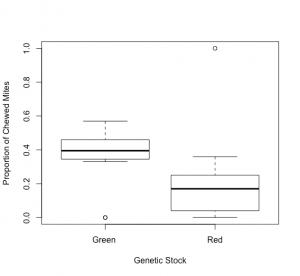
We feel that despite the poor return of data, and it quality that the project is success. It achieved its objective of increasing knowledge, and improving attitudes about beekeeping practices. The was lots of chatter about the project and interest in helping, and having their colonies be more productive and stay alive. But, still human nature being what it is, we will still rather eat chocolate and watch TV instead of going to the gym and having a kale smoothie for dinner.
This is not unusual for citizen science type projects. This being said, the projects themselves are still extremely valuable and worthwhile, and should continue to be improved upon and expanded. If the high losses (generally 45-50%) of colonies is ever to change, beekeepers attitudes, knowledge, and skill level must change.
Education & Outreach Activities and Participation Summary
Participation Summary:
We had several field days to improve the awareness, knowledge and skill of the local beekeepers: they were held in June 2018:
Linesville, PA- NW PA Beekeepers Assoc.
Dover, PA- York County Beekeepers Assoc. & PA Queen Bee Improvement Project
Ebensburg, PA- 2Cs and a B Beekeepers Assoc.
Pittsburgh, PA- Burgh Bees
Slippery Rock, PA- PA Queen Bee Improvement Project
Findley, OH- W Central Ohio Beekeepers
State College, PA- PA State Beekeepers Assoc (Nov) update during Annual Mtg.
Learning Outcomes
Our objective was to change the behavior of 100 hobbyist beekeepers by having them compare colonies with queens from a MBB/mite-resistant stock versus Control. The actual measured results of the stock comparison is not really as important as changing behavior/attitudes of the beekeepers themselves; using education of how to sample and treat for mites.
We had field days as part of the PA Queen Bee Improvement Project in Linesville, Ebensburg, Pittsburgh, Slippery Rock, and Kutztown, PA. Also, events were held in Findley, Ohio and and around Morgantown, WV.
Beekeepers were shown how to perform the 'alcohol wash' method so they can count the number of mites present, expressed as percentage. Some demonstrations of how to perform and mite-chewing assay were done where we had the right facilities to do so. Queen introduction, raising and making splits were part of the field events. The field events covered many general topics, and many were fascinated and and paid attention. However, when it came time for them actually perform these measurements for the study, it was less that perfect. Hands-on demonstrations and classroom education is start, but progress is frustratingly slow.
We feel we have indeed increased the knowledge, attitude, and awareness about monitoring mite infestations, and the needed treatment, of the beekeepers in the study and the participating clubs. But implementation of these skill by the beekeepers in day to day practice is still poor. We can say this because 76% of the beekeepers did not perform any measurement at all, and of the 24% that did turn in data, about half was incomplete. Because of these results, it made data analysis difficult.
Project Outcomes
We distributed 100 pairs of queens to the participants, and received data back for 24 sets out of the 100. These participants changed their recordkeeping though could improve their follow-through with complete data collection.
Looking back over the project we can say it was a success. Primarily, we can say this because it raised awareness of what we are doing by trying to get beekeepers to adopt improved genetics, along with the other IPM practices that are part of successful beekeeping in the age of Varroa mites. Even if they did not receive project queens, they knew people who were excited to participate, and even if those with queens did not collect field data, they were still excited be part of something worthy.
Although misguided, we expected better participation by the clubs themselves by encouraging and supporting their club members. Two clubs turned in zero data, and one club only turned in one data set, this was disappointing considering the large number of queens they were given. The value of the queens given to these clubs exceeded $3,000. We feel that if people had to pay a small portion of the cost for the queen they would do a better job of being a 'stake-holder', as opposed to free. If its free they do not 'have any skin in the game' so to speak. The WV club turned in 100 percent of their data along with an excellent report- great job guys!
Moving forward, the PA Queen Improvement Project, HHBBC, and other states queen organizations still plan to hold field days and distribute improved mite resistant/MBB genetics to as many beekeepers as possible. We are not discouraged, and will continue to tweak the program each year, and recruit and train more IPM beekeepers. Our goal remains the same as it was in 2011- to improve the neighborhood!
